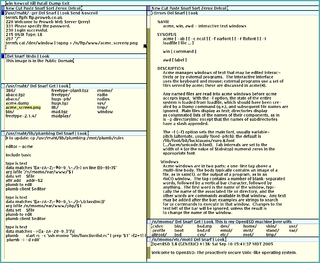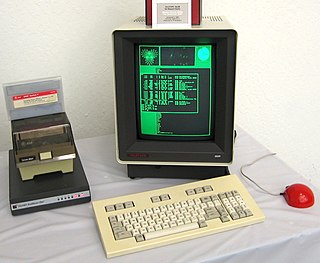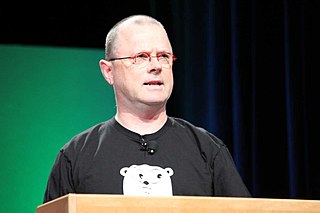Related Research Articles

Plan 9 from Bell Labs is a distributed operating system which originated from the Computing Science Research Center (CSRC) at Bell Labs in the mid-1980s and built on UNIX concepts first developed there in the late 1960s. Since 2000, Plan 9 has been free and open-source. The final official release was in early 2015.

Acme is a text editor and graphical shell from the Plan 9 from Bell Labs operating system, designed and implemented by Rob Pike. It can use the Sam command language. The design of the interface was influenced by Oberon. It is different from other editing environments in that it acts as a 9P server. A distinctive element of the user interface is mouse chording.

The Unix philosophy, originated by Ken Thompson, is a set of cultural norms and philosophical approaches to minimalist, modular software development. It is based on the experience of leading developers of the Unix operating system. Early Unix developers were important in bringing the concepts of modularity and reusability into software engineering practice, spawning a "software tools" movement. Over time, the leading developers of Unix established a set of cultural norms for developing software; these norms became as important and influential as the technology of Unix itself, and have been termed the "Unix philosophy."
Limbo is a programming language for writing distributed systems and is the language used to write applications for the Inferno operating system. It was designed at Bell Labs by Sean Dorward, Phil Winterbottom, and Rob Pike.

Sam is a multi-file text editor based on structural regular expressions. It was originally designed in the early 1980s at Bell Labs by Rob Pike with the help of Ken Thompson and other Unix developers for the Blit windowing terminal running on v9 Unix; it was later ported to other systems. Sam follows a classical modular Unix aesthetic. It is internally simple, its power leveraged by the composability of a small command language and extensibility through shell integration.

rio is Plan 9 from Bell Labs' windowing system. It is well known for making its window management transparent to the application. This allows running rio inside of another window manager.

In computing, a visual programming language, also known as diagrammatic programming, graphical programming or block coding, is a programming language that lets users create programs by manipulating program elements graphically rather than by specifying them textually. A VPL allows programming with visual expressions, spatial arrangements of text and graphic symbols, used either as elements of syntax or secondary notation. For example, many VPLs are based on the idea of "boxes and arrows", where boxes or other screen objects are treated as entities, connected by arrows, lines or arcs which represent relations. VPLs are generally the basis of Low-code development platforms.

Inferno is a distributed operating system started at Bell Labs and now developed and maintained by Vita Nuova Holdings as free software under the MIT License. Inferno was based on the experience gained with Plan 9 from Bell Labs, and the further research of Bell Labs into operating systems, languages, on-the-fly compilers, graphics, security, networking and portability. The name of the operating system, many of its associated programs, and that of the current company, were inspired by Dante Alighieri's Divine Comedy. In Italian, Inferno means "hell", of which there are nine circles in Dante's Divine Comedy.

Blit is a programmable raster graphics computer terminal designed by Rob Pike and Bart Locanthi Jr. of Bell Labs and released in 1982.
Alef is a discontinued concurrent programming language, designed as part of the Plan 9 operating system by Phil Winterbottom of Bell Labs. It implemented the channel-based concurrency model of Newsqueak in a compiled, C-like language.
Concurrent computing is a form of computing in which several computations are executed concurrently—during overlapping time periods—instead of sequentially—with one completing before the next starts.
The actor model and process calculi share an interesting history and co-evolution.

Robert Pike is a Canadian programmer and author. He is best known for his work on the Go programming language while working at Google and the Plan 9 operating system while working at Bell Labs, where he was a member of the Unix team.

Go is a fast statically typed, compiled high-level general purpose programming language. It is known for its simplicity and efficiency. It was designed at Google in 2009 by Robert Griesemer, Rob Pike, and Ken Thompson. It is syntactically similar to C, but also has memory safety, garbage collection, structural typing, and CSP-style concurrency. It is often referred to as Golang because of its former domain name, golang.org, but its proper name is Go.

Object-oriented programming (OOP) is a programming paradigm based on the concept of objects, which can contain data and code: data in the form of fields, and code in the form of procedures. In OOP, computer programs are designed by making them out of objects that interact with one another.
OpenModelica is a free and open source environment based on the Modelica modeling language for modeling, simulating, optimizing and analyzing complex dynamic systems. This software is actively developed by Open Source Modelica Consortium, a non-profit, non-governmental organization. The Open Source Modelica Consortium is run as a project of RISE SICS East AB in collaboration with Linköping University.
References
- ↑ "Frequently Asked Questions".
- ↑ "Influences - The Rust Reference". The Rust Reference. Retrieved 2023-04-18.
- ↑ Pike, Rob (1990). "The Implementation of Newsqueak" (PDF). Software: Practice and Experience. 20 (7): 649–659. doi:10.1002/spe.4380200703.
- ↑ Cardelli, Luca; Pike, Rob (1985). Squeak: a language for communicating with mice (PDF). ACM SIGGRAPH.
- ↑ Pike, Rob (1994). Newsqueak: A Language for Communicating with Mice (PDF) (Technical report). Bell Labs. Computing Science Technical Report No. 143.
- ↑ Hinchee, Sean (2020). "Go's History in Code". seh.dev. Retrieved October 25, 2021.